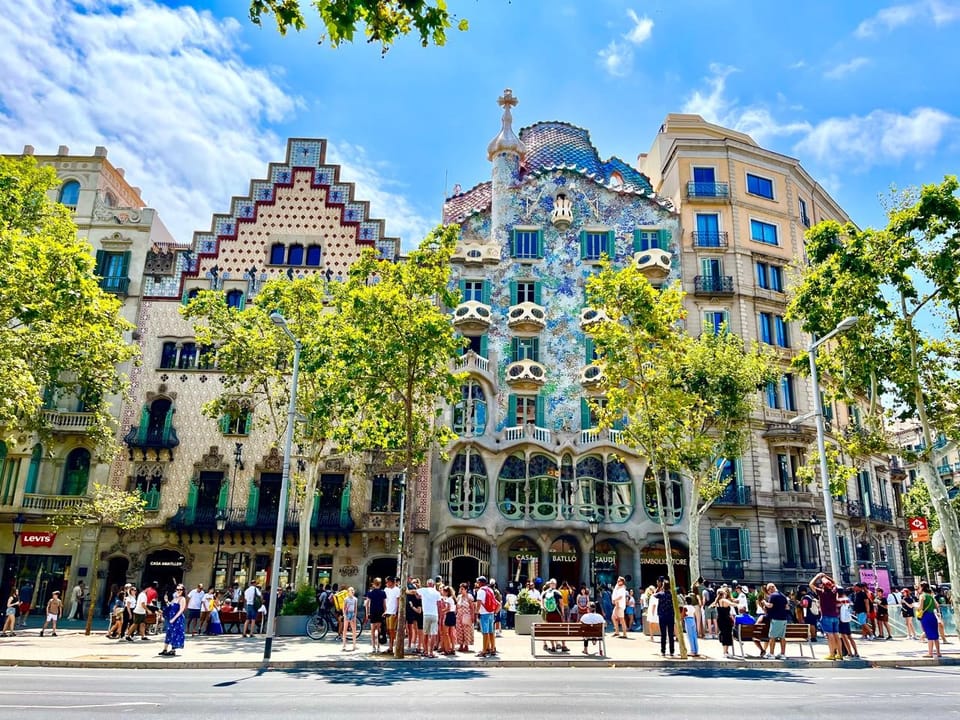The city of Barcelona, on the Iberian Peninsula, has long been considered a place of exchange, with a strong commercial nature. Open port to the Mediterranean, it has always had projection overseas for its economic and cultural dynamics. The expression in Catalan, the native language spoken to the present day in the region, which gives the title to this article, is of Italian origin, attributed to its merchants, who said that the city was good when they managed to sell their products (METROPOLI, 2024). Thus, Barcelona, whether it wants to or not, has been stigmatized, over time, for being a territory of capital, present, in a more or less ostensive way, in the socioeconomic relations of the city, in the sense that it will always be better to live it, when the money is in your pocket to do so. However, in addition to this expression, there is a saying that complements it, not always taken into account, which is: "... però tant si sona com si no sona, Barcelona sempre és bona", that is, the city always welcomes the visitor with open arms, regardless of the money they take with them (PADRONEL, 2014).
Dilemmas aside, it is clear that here, in this text, it is a matter of conveying the look and feeling of this author, in the face of a recent nostalgic tourist visit to the city where he lived and that welcomed him in a certain period of his life, more precisely, in the period of preparation of the city for the 1992 Olympic Games.
It can be observed that the need to project itself in an increasingly autonomous way, especially after the aforementioned Olympic Games, when the Spanish State became part of the European Union, was strengthened by the opportunities that were created and the new urban, social, economic and cultural dynamics that were fostered in the city. This favored a generalized desire to get to know the city, which since then, has been intensifying exponentially in the world, especially, as mentioned, due to the global exposure that the Games allowed to make, increasingly providing the tourist massification of the city.
Places, equipment and services that were previously freely and easily accessed by their residents and even by tourists, have become disputed, which has been promoting a true spatial stratification of their territory, generating functional hierarchies, preferential uses and priority recipients in the enjoyment and appropriation of their territory and its attractions.
Thus, the growing influx of visitors, resulting from this and associated with factors that facilitate access to the destination, such as those related to transport modes, with cheaper travel on flights of airlines from Low COST , land lines of bus companies increasingly connected to European radiating centers, in addition to the operation of high-speed trains shortening distances between locations, and those related to the types of accommodation that have proliferated in the destination and surroundings, expanding the offer within the existing accommodation network, as well as the proliferation of services fast-food , with a relative cheapening of the needs for food restoration, intensified the consumption of existing tourist attractions and the urban externalities associated with them.
Thus, based on Aalbers who defines financialization as "the growing dominance of financial actors, markets, practices, measures and financial narratives, at various scales, resulting in a structural transformation of economies, companies (including financial institutions), states and families" (AALBERS, 2015, p. 214), and more with the aim of "shedding light on the theme of financialization and its nexus with the territory" (BONICENHA, 2017, p.03), and in this particular, from the perspective of the city's tourist commodification, the transformation of urban, social and cultural resources, par excellence, into economic products, in the face of tourist massification, are making it more expensive, obstructing and stratifying access to these "touristified" assets due to their intense economic consumption.
For example, public spaces, previously free and unrestricted access, such as Park Güell, now have "filters" for their enjoyment, through paid access, justified, in the political-institutional discourse, as a way to ensure their conservation and safe use, thus allowing the improvement of their conditions of use over time, as a tourist attraction of importance to the city. It should be noted that, in the so-called "filters" mentioned above, residents who, through registration with the municipal administration, prove their residence, whether in the vicinity of the park or in the city, will have a free entrance, ensuring, free of charge, as Barcelona citizens, the enjoyment of their city, because they live in it. A personal, non-transferable access card with an identifier number signals your status. Thus, "the objective of access management is to control access to Park Güell, in order to avoid overcrowding, movements and crowds in the heritage area, thus ensuring its safety, its correct use, its conservation and the quality of the visit" (PARKGUELL, n.d.).
Other situations can be mentioned. I highlight here the case of Mercat de la Boquería , in the old central area of the city, which has become a true gastronomic space, in addition to spot of reference for creative tourism, from the realization of a tour of its facilities with a view to the purchase of ingredients to, under the command of a chef, prepare dishes of local cuisine, such as tapas, sangrias and Paellas . In this case, the transformation of the traditional market space is evident, by assuming, in the face of the emerging demands for tourist functionality, the role of a leisure and leisure space that, due to the high demand, has become an unwelcoming environment, due to an overstretched load capacity, in addition to becoming an exclusive and expensive space.
This and other environments in the city end up driving away their current users, for a progressive replacement in the name of visitors who, due to the tourist financialization of the city, can and do pay more for their enjoyment. This is at the cost of a certain degree of resentment of the local inhabitants who see themselves being overlooked and seek other environments to satisfy their needs and interests, generating, to a greater or lesser extent, segregationist processes in the city.
It could, in opposition to reactive social movements of rejection of tourists in the city, highlight local initiatives that already existed and that help to temporize this situation, such as the promotion of free and scheduled visits for all users, especially in museum facilities, as well as the promotion of open and unrestricted events to the general public, especially in periods of more tourist influx, to make cultural and leisure activities more accessible to all, such as summer festivals, or greater support and promotion of popular festivals in the city, such as La Mercé or the Fiesta Mayor de Gracia .

Record of a demonstration in the Gracia neighborhood, Barcelona, Spain. Personal collection.
Thus, the movements manifested in the graphics of "tourists go home" in Barcelona express a discontent of Barcelona's social sectors that see, in particular, the prices of real estate rents in the city rise by more than 30% in the last five years (FERNANDEZ, 2024). Another aspect that is also relevant is the transformation of uses in certain areas of the city, especially traditional local businesses that, having been maintained over time, despite the business offer of large facilities such as shopping centers and supermarkets established from the second half of the last century, due to the ostensible tourist appeal in certain areas of the city, are progressively transformed with the urban specialization of tourist areas such as the Ramblas in Ciutat Vella , and the areas adjacent to the Expiatory Temple of the Sagrada Familia, by the architect Antoni Gaudi, in the Eixample , which have become areas of commercial offer exclusively aimed at visitors (AJUNTAMENT DE BARCELONA, BARCELONA ACTIVA, 2023).
In this way, processes of gentrification of urban areas proliferate (HAMNET, 2003; GLASS, 1964; CAMPOS, n.d.), which, in this case, have focused on environments with powerful architectural and urban heritage content, transforming considerable areas due to their socio-spatial segregation, which is characterized by its accentuated appreciation, resulting in the progressive departure of residents and current users due to the increase in the local cost of living and the consumption of their equipment and services.
On the other hand, directly or indirectly, the touristification of places by the attractions there (HERNÁNDEZ-RAMÍREZ, 2018; NOVY, 2017), can favor or even finance the recovery of spaces where these attractions are located, as well as promote their own conservation. In addition, they can foster the dynamization of local activities that, associated with tourism, enable their economic reinsertion and revaluation in the urban context of the city. However, it is certain that this touristification charges its bill for the monetization of everything that can be offered and occur in those places. Thus, tourist taxes, which at first had a more voluntary experimental character and solidarity with the locality, have become increasingly mandatory in urban contexts and which, according to the corresponding regulations, must have a clear and pragmatic destination.
In the case of Barcelona, this tourist tax, established by law and justified to provide financial support for the improvement and maintenance of infrastructure and services related to tourism in the city, such as maintenance of monuments, museums and public areas, tourism promotion in its marketing campaigns, support for public security, cleaning and transport services, financing of local cultural events and activities, among others (Cf. GENERALITAT DE CATALUNYA. LLei No. 5/2017, of March 28; BARCELONA COUNCIL Tax Ordinance No. 2.2/2020, of December 23), has also been used for the application of surcharges to justify itself much more as a means to contain mass tourism in the city, in the face of the growing influx of tourists.
Its application occurs, par excellence, within the city's accommodation sector, and in the case of private rental accommodations of varying duration, such as those accessed through the platform Airbnb , is a requirement to be met if the visitor wants to effectively use this service. Thus, 6.05 euros per person/night are charged, for up to 7 consecutive nights, with minors up to 16 years old being exempt (Cf. AIRBNB, n.d.)
From this collection instrument, the Tax on Stays in Tourist Establishments (IEETS), values of around 95 million euros are expected to be computed in favor of the municipal coffers in 2024, and this amount may be increased if an increase in this surcharge is approved later this year as of October this year, which could amount to 115 million euros (CHECKINSCAN, 2024).
Despite this, the tourist massification in the city, characterized by the phenomenon of Overtourism (VAGENA, 2021; BROWN, s.d.), which estimates to receive 32 million annual visitors to the city (RAMOS,., 2024), still has no clear solution on how to face the challenge of being a global tourist offer without losing the quality of life that it needs to ensure for its citizens and those who visit it, demonstrating that Barcelona is a victim of its own success (PLUSH, 2017).
It is, therefore, an equation that is difficult to operate, but which needs a series of resolutions, which is certainly demanding a systematic debate on which strategies, in a transversal perspective, to adopt in a forceful, consistent and permanent way to achieve a level of adequate realization of tourism activity that is socially just, economically viable, culturally diverse and environmentally balanced.
REFERENCES
AALBERS, M. The potential for financialization. Dialogues in human geography, 2015, 5(2), 214-219.
AJUNTAMENT OF BARCELONA. Ordenanza Fiscal No. 2.2/2020, of 23 December. Ordenança Fiscal Reguladora del Recàrrec a L'impost sobre les Estades en Establiments Turístics. Barcelona, 2020.
BARCELONA AJUNTAMENT; BARCELONA ACTIVE. Commerce and Tourism. Sector report. Barcelona, 2023.
Barcelona: Paella Cooking Experience & Boqueria Market Tour. Get your Guide. Available at: https://www.getyourguide.com/pt-br/barcelona-l45/aula-de-culinaria-c-paella-e-tour-la-boqueria-t44533/?ranking_uuid=67240773-1982-4934-8b52-7d3abecc773c . Accessed in: 09/13/23.
BONICENHA, R. C. Financialization and Territory: a review of the recent literature. Development, crisis and resistance: what are the paths of Urban and Regional Planning? XVII ENANPUR, São Paulo, 2017, pp. 1-16.
BROWN, Vicky. Overtourism in Barcelona. Responsible travel, s.d. Available at: https://www.responsibletravel.com/copy/overtourism-in-barcelona . Accessed in: 09/13/2024.
CAMPOS, M. Gentrification. Mundo Educação, n.d. Available at: https://mundoeducacao.uol.com.br/geografia/gentrificacao.htm#:~:text=A%20gentrifica%C3%A7%C3%A3o%20%C3%A9%20o%20termo,local%20do%20custo%20de%20vida . Accessed in: 09/13/2024.
FERNANDEZ, David. Se dispara, otra vez, el precio de los alquileres en Barcelona. La Razón. 01.07.2024. Available at: https://www.larazon.es/cataluna/barcelona/dispara-otra-vez-precio-alquileres-barcelona_2024070166827e390de31e0001f71add.html#:~:text=El%20precio%20medio%20del%20alquiler,al%20%C3%BAltimo%20trimestre%20de%202023 . Accessed in: 09/13/2024.
GENERALITAT DE CATALUNYA. Law No. 5/2017, of March 28, of fiscal measures, administratives, financeres i del sector públic i de creació i regulació dels imposto sobre grans establiments comercials, sobre estades en establiments turístics, sobre elements radiotòxics, sobre begudes ensucrades envasades i sobre emissions de dioxid de carboni. Barcelona, 2017.
GLASS, R. Introduction to London: aspects of change. Centre for Urban Studies, London, 1964. Reprinted in GLASS, R. Cliche ́s of Urban Doom, pp. 132–158. Oxford: Blackwell, 1989.
HAMNETT, C. Gentrification and the Middle-class Remaking of Inner London, 1961–2001. Urban Studies, Vol. 40, No. 12, 2401–2426, November 2003.
HERNÁNDEZ-RAMÍREZ, J. La voracidad del turismo y el derecho a la ciudad. Revista Andaluza de Antropología, 15, pp. 22-46, 2018.
NOVY, J. 'Destination' Berlin revisited. From (new) tourism towards a pentagon of mobility and place consumption. Tourism Geographies, 20(3), 418-442, 2017.
Origen de dichos y expresiones: 'Barcelona és bona si la bossa sona'. PADRONEL, 19/08/2014. Available at: https://padronel.blog/2014/08/28/le-origen-de-dichos-y-expresiones-barcelona-s-bona-si-la-bossa-sona/ . Accessed in: 09/13/2024.
PARKGUELL. ¿Por qué la gestión de accesos? Park Güell – Web. Official. Ajuntament de Barcelona. Available at: https://parkguell.barcelona/es/un-parque-para-todo-el-mundo/por-que-la-gestion-de-accesos . Accessed in: 09/13/2024.
PLUSH, H. Barcelona unveils new law to keep tourists away. 2017. The Telegraph. Travel. Available at: https://www.telegraph.co.uk/travel/destinations/europe/spain/catalonia/barcelona/articles/barcelona-unveils-new-law-to-keep-tourists-away/?ICID=continue_without_subscribing_reg_first . Accessed in: 09/13/2024.
RAMOS, K. Barcelona should increase tourism tax to 4 in October in action against overturism. COPASTUR, 07/22/2024. Available at: https://www.copastur.com.br/blog/barcelona-deve-aumentar-taxa-de-turismo/ . Accessed in: 09/14/2024.
Sagrada Familia I. AIRBNB, n.d. Available at: https://www.airbnb.com.br/rooms/5097014?source_impression_id=p3_1726326877_P3C1xvxitP9rYExG . Accessed in: 09/14/2024.
Tourist tax in Barcelona in force by type of accommodation. CHECKINSCAN, 2024.
Available at: https://www.checkinscan.com/pt/imposto-turistico-de-barcelona/#:~:text=Esta%20medida%20poder%C3%A1%20entrar%20em,sobretaxa%20possa%20exceder%20o%20atual . Accessed in: 09/14/2024.
VAGENA, A. OVERTOURISM: Definition and Impact. Academia Letters, Article 1207, June 2021.
Live in Barcelona . These are the most famous refranes in Barcelona. METROPOLI, 24/03/2024. Available at: https://metropoliabierta.elespanol.com/vivir-en-barcelona/20230814/estos-son-los-dichos-refranes-mas-famosos-de-barcelona/786671582_0.html . Accessed in: 09/13/2024.


